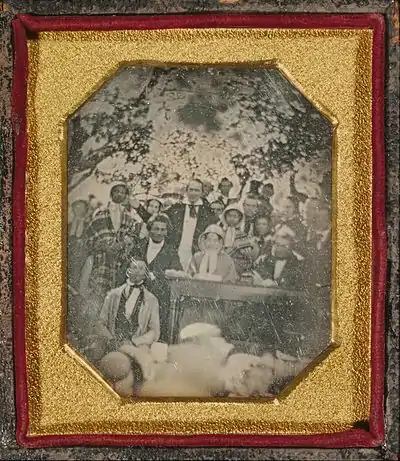Fugitive Slave Law Convention
The Fugitive Slave Law Convention was held in Cazenovia, New York, August 21–22, 1850.[1][2] Organized to oppose passage of the Fugitive Slave Act of 1850 by the United States Congress, participants included Frederick Douglass, the Edmonson sisters, Gerrit Smith, Samuel Joseph May, and Theodore Dwight Weld, among others.[2] The convention opened at the First Congregational Church of Cazenovia (now Cazenovia College's theater building), then moved to "the orchard of Grace Wilson's School, located on Sullivan Street,"[2] to accommodate the estimated 2000 to 3000 participants.[2][1] It was chaired by Douglass.[1]

John Brown "made a very fiery speech" concerning his need of funds to buy arms for his and his sons' use in Kansas; funds were contributed on the spot, principally by Gerrit Smith.[3]
The daguerreotype
There is one and only one visual image of the meeting, in the daguerreotype held by the Madison County Historical Society. A photographer was summoned to take the picture, which was intended to show William L. Chaplin, in jail in Washington for having assisted two slaves in an unsuccessful escape attempt. Chaplin's future wife, Theodosia Gilbert Chaplin, is seated at the table with pen and paper in hand, documenting through the picture that "the document" was indeed prepared by the group. To her right is Frederic Douglass; behind her stands Gerrit Smith.
Convention proceedings
During the convention, William L. Chaplin was discussed.[4] Chaplin was a radical political abolitionist who helped plan the escape of 77 slaves from Washington, D.C.[5] This plan ultimately failed and later, Chaplin was arrested after he was caught driving a carriage with two escaped slaves.[5] His fiancée, Theodosia Gilbert, attended the convention.[5] There was a resolution by James C. Jackson that was adopted to create a committee to raise money in order to liberate Chaplin.[4] He advised them to raise 20,000 dollars in 30 days.[4]
An open letter titled “To American Slaves from Those Who Have Fled from American Slavery” was introduced to the attendees by Gerrit Smith.[6] This letter advocated for the abolition of slavery and even the use of violence in order to escape.[6] It also discusses the current situation of the country with the Fugitive Slave Law enacted and presents 17 resolutions which they adopted during the convention.[4] These resolutions outlined the evils of slavery, the greatness of abolitionists like William L. Chaplin, and the convention's commitment to support other organizations and people who support abolition and African-Americans.[4]
Convention leadership and groups
The meeting started out with temporary chairman Samuel Joseph May and temporary secretary Samuel Thomas Jr.[4] May then appointed Samuel Wells, J.W. Loguen, and Charles B. Ray to a committee to nominate official officers.[4] Later in the convention, official officers were appointed by this committee to major positions. Frederick Douglass was appointed to president.[4] Joseph C. Hathaway, Francis Hawley, Chas. B. Ray, and Chas. A. Wheaton were appointed for vice presidents.[4] Charles D. Miller and Anne V. Adams were appointed for secretaries.[4]
Joseph C. Hathaway, William R. Smith, Eleazer Seymour, and James C. Jackson were appointed to nominate people for the “Chaplin Committee”.[4] This committee ended up consisting of around 19 people.[4] Some of the committee members included James C. Jackson, Joseph C. Hathaway, William R. Smith, and George W. Lawson.[4]
A group of women including Mrs. F. Rice, Phebe Hathaway, and Louisa Burnett were appointed to nominate a committee of females.[4] This committee would obtain a silver pitcher and two silver goblets to present them to William C. Chaplin, in honor of “his distinguished services in the cause of humanity.”[4]
Many of the participants of this convention were also involved in a later anti-fugitive slave law meeting in Syracuse, New York on Tuesday, January 7, 1851.[7]
External links
References
- Baker, Robert A. (4 February 2005). "Cazenovia convention: A meeting of minds to abolish slavery". The Post-Standard. Retrieved 5 February 2017.
- Weiskotten, Daniel H. (25 May 2003). "The 'Great Cazenovia Fugitive Slave Law Convention' at Cazenovia, NY, August 21 and 22, 1850". RootsWeb. Ancestry.com. Retrieved 5 February 2017.
- "Old John Brown". Herald of Freedom (Lawrence, Kansas). October 29, 1859. p. 2 – via newspapers.com.
- Foner, Philip S., ed. (1979). Proceedings of the Black State Conventions, 1840-1865: Volume 1. Philadelphia: Temple University Press. pp. 43–53.
- Harrold, Stanley. "The Cazenovia Convention". Historians Against Slavery. Retrieved March 5, 2020.
- "Site of Fugitive Slave Law Convention". Freethought Trail. Retrieved March 5, 2020.
- "Anti-Fugitive Slave Law State Convention". New York Daily Tribune. January 9, 1851.